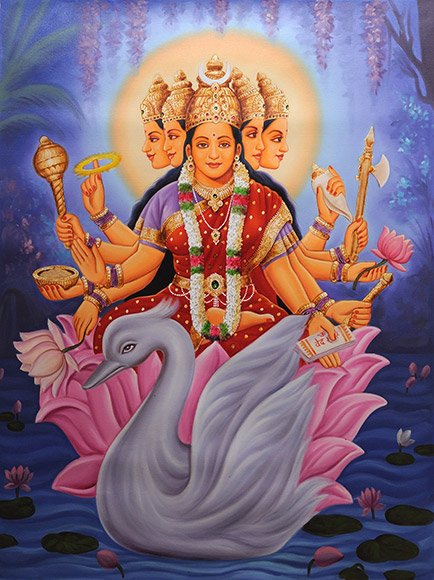Samskriti, Saṃskṛti: 9 definitions
Introduction:
Samskriti means something in Hinduism, Sanskrit, Marathi, Hindi. If you want to know the exact meaning, history, etymology or English translation of this term then check out the descriptions on this page. Add your comment or reference to a book if you want to contribute to this summary article.
The Sanskrit term Saṃskṛti can be transliterated into English as Samskrti or Samskriti, using the IAST transliteration scheme (?).
Alternative spellings of this word include Sanskrati.
In Hinduism
Chandas (prosody, study of Sanskrit metres)
Source: Shodhganga: a concise history of Sanskrit Chanda literatureSaṃskṛti (संस्कृति) is one of the twenty-six varieties of Sanskrit metres (chandas) mentioned in the Chandaśśāstra 1.15-19. There are 26 Vedic metres starting with 1 to 26 letters in each pāda. It is a common belief that the classical metres are developed from these 26 metres. Generally a metre has a specific name according to it’s number of syllables (akṣara). But sometimes the same stanza is called by the name of another metre from the point of view of the pādas.

Chandas (छन्दस्) refers to Sanskrit prosody and represents one of the six Vedangas (auxiliary disciplines belonging to the study of the Vedas). The science of prosody (chandas-shastra) focusses on the study of the poetic meters such as the commonly known twenty-six metres mentioned by Pingalas.
Languages of India and abroad
Marathi-English dictionary
Source: DDSA: The Aryabhusan school dictionary, Marathi-Englishsaṃskṛti (संस्कृति).—f Refinement, Civilisation.
Marathi is an Indo-European language having over 70 million native speakers people in (predominantly) Maharashtra India. Marathi, like many other Indo-Aryan languages, evolved from early forms of Prakrit, which itself is a subset of Sanskrit, one of the most ancient languages of the world.
Sanskrit dictionary
Source: DDSA: The practical Sanskrit-English dictionarySaṃskṛti (संस्कृति).—
1) = संस्कार (saṃskāra).
2) Preparation.
3) Perfection.
4) Determination.
5) (Modern usage) Civilization, culture.
Derivable forms: saṃskṛtiḥ (संस्कृतिः).
Source: Cologne Digital Sanskrit Dictionaries: Cappeller Sanskrit-English DictionarySaṃskṛti (संस्कृति).—[feminine] = seq. + consecration, initiation.
Source: Cologne Digital Sanskrit Dictionaries: Monier-Williams Sanskrit-English Dictionary1) Saṃskṛti (संस्कृति):—[=saṃ-skṛti] [from saṃs-kṛ] f. making ready, preparation, perfection, [Vājasaneyi-saṃhitā] etc. etc.
2) [v.s. ...] formation, [Aitareya-brāhmaṇa]
3) [v.s. ...] hallowing, consecration, [Bhāgavata-purāṇa]
4) [v.s. ...] determination, effort, [cf. Lexicographers, esp. such as amarasiṃha, halāyudha, hemacandra, etc.]
5) [v.s. ...] m. Name of Kṛṣṇa, [Mahābhārata] ([Bombay edition] saṃ-skṛta)
6) [v.s. ...] of a king, [Viṣṇu-purāṇa] ([varia lectio] saṃ-kṛti).
Source: DDSA: Paia-sadda-mahannavo; a comprehensive Prakrit Hindi dictionary (S)Saṃskṛti (संस्कृति) in the Sanskrit language is related to the Prakrit word: Saṃkhaḍi.
[Sanskrit to German]
Sanskrit, also spelled संस्कृतम् (saṃskṛtam), is an ancient language of India commonly seen as the grandmother of the Indo-European language family (even English!). Closely allied with Prakrit and Pali, Sanskrit is more exhaustive in both grammar and terms and has the most extensive collection of literature in the world, greatly surpassing its sister-languages Greek and Latin.
Hindi dictionary
Source: DDSA: A practical Hindi-English dictionarySaṃskṛti (संस्कृति) [Also spelled sanskrati]:—(nf) culture; ~[hīna] uncultured, having no culture.
...
Kannada-English dictionary
Source: Alar: Kannada-English corpusSaṃskṛti (ಸಂಸ್ಕೃತಿ):—
1) [noun] development, improvement or refinement of the intellect, emotions, interests, manners, and taste; culture.
2) [noun] the result of this, as reflcted in one’s way of thinking, talking, behaviour, etc.; cultural refinement; refinement of thought and cultural appreciation; culture.
3) [noun] an advanced state of human society, in which a high level of culture, science, industry, and government has been reached; civilisation.
4) [noun] those people or nations that have reached such a state; a civilisation.
Kannada is a Dravidian language (as opposed to the Indo-European language family) mainly spoken in the southwestern region of India.
See also (Relevant definitions)
Partial matches: Sam.
Starts with: Samskritihina, Samskritika, Samskritika-sampada, Samskritikarana, Samskritikarisu, Samskritisu, Samskritivid.
Ends with: Adhisamskriti, Asamskriti, Bhautika-samskriti, Cyutasamskriti, Purviya-samskriti, Raute-samskriti, Vaidikasamskriti.
Full-text (+2): Cyutasamskara, Sankhati, Bhautika-samskriti, Purviya-samskriti, Videshi-samskriti-prema, Bhautik-samskruti, Poorviy-samskruti, Cyutasamskriti, Sankhadi, Samasik, Sanskrati, Samasika, Nisankhiti, Hrasonmukha, Hrasonmukh, Vang, Vamga, Guna-karma, Van, Vana.
Relevant text
Search found 14 books and stories containing Samskriti, Saṃskṛti, Samskrti, Sam-skriti, Saṃ-skṛti, Sam-skrti, Samskṛti; (plurals include: Samskritis, Saṃskṛtis, Samskrtis, skritis, skṛtis, skrtis, Samskṛtis). You can also click to the full overview containing English textual excerpts. Below are direct links for the most relevant articles:
The Tattvasangraha [with commentary] (by Ganganatha Jha)
Verse 2189 < [Chapter 24a - The case for the reliability of the Veda (the Revealed Word)]
Verse 2171 < [Chapter 24a - The case for the reliability of the Veda (the Revealed Word)]
Verse 2566-2567 < [Chapter 24b - Arguments against the reliability of the Veda (the Revealed Word)]
Sahitya-kaumudi by Baladeva Vidyabhushana (by Gaurapada Dāsa)
Harshacharita (socio-cultural Study) (by Mrs. Nandita Sarmah)
Part 6: On Society, Culture and Socio-Cultural Study < [Chapter 1 - Introduction]
Jain Science and Spirituality (by Medhavi Jain)
2.2. Cosmic and Supracosmic Space < [Chapter 5 - Science in Jainism]
Atharvaveda and Charaka Samhita (by Laxmi Maji)
Aims of the present work < [Chapter 1 - Introduction]
Kavyamimamsa of Rajasekhara (Study) (by Debabrata Barai)
Part 8.2 - Rājaśekhara’s concepts of Seven Mahādvīpas (islands) < [Chapter 5 - Analyasis and Interpretations of the Kāvyamīmāṃsā]